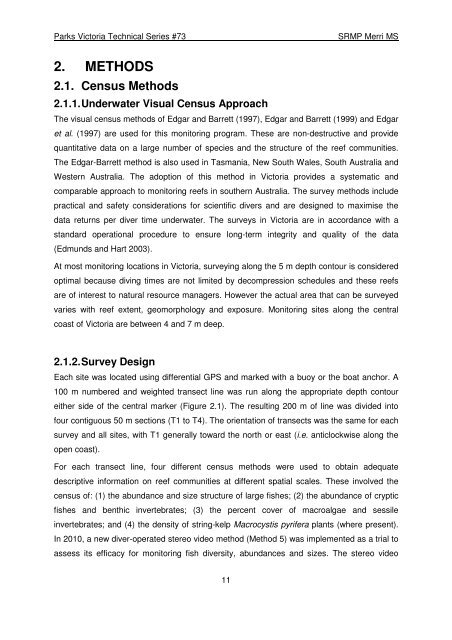Victorian Subtidal Reef Monitoring Program - Parks Victoria
Victorian Subtidal Reef Monitoring Program - Parks Victoria
Victorian Subtidal Reef Monitoring Program - Parks Victoria
You also want an ePaper? Increase the reach of your titles
YUMPU automatically turns print PDFs into web optimized ePapers that Google loves.
<strong>Parks</strong> <strong>Victoria</strong> Technical Series #73<br />
SRMP Merri MS<br />
2. METHODS<br />
2.1. Census Methods<br />
2.1.1. Underwater Visual Census Approach<br />
The visual census methods of Edgar and Barrett (1997), Edgar and Barrett (1999) and Edgar<br />
et al. (1997) are used for this monitoring program. These are non-destructive and provide<br />
quantitative data on a large number of species and the structure of the reef communities.<br />
The Edgar-Barrett method is also used in Tasmania, New South Wales, South Australia and<br />
Western Australia. The adoption of this method in <strong>Victoria</strong> provides a systematic and<br />
comparable approach to monitoring reefs in southern Australia. The survey methods include<br />
practical and safety considerations for scientific divers and are designed to maximise the<br />
data returns per diver time underwater. The surveys in <strong>Victoria</strong> are in accordance with a<br />
standard operational procedure to ensure long-term integrity and quality of the data<br />
(Edmunds and Hart 2003).<br />
At most monitoring locations in <strong>Victoria</strong>, surveying along the 5 m depth contour is considered<br />
optimal because diving times are not limited by decompression schedules and these reefs<br />
are of interest to natural resource managers. However the actual area that can be surveyed<br />
varies with reef extent, geomorphology and exposure. <strong>Monitoring</strong> sites along the central<br />
coast of <strong>Victoria</strong> are between 4 and 7 m deep.<br />
2.1.2. Survey Design<br />
Each site was located using differential GPS and marked with a buoy or the boat anchor. A<br />
100 m numbered and weighted transect line was run along the appropriate depth contour<br />
either side of the central marker (Figure 2.1). The resulting 200 m of line was divided into<br />
four contiguous 50 m sections (T1 to T4). The orientation of transects was the same for each<br />
survey and all sites, with T1 generally toward the north or east (i.e. anticlockwise along the<br />
open coast).<br />
For each transect line, four different census methods were used to obtain adequate<br />
descriptive information on reef communities at different spatial scales. These involved the<br />
census of: (1) the abundance and size structure of large fishes; (2) the abundance of cryptic<br />
fishes and benthic invertebrates; (3) the percent cover of macroalgae and sessile<br />
invertebrates; and (4) the density of string-kelp Macrocystis pyrifera plants (where present).<br />
In 2010, a new diver-operated stereo video method (Method 5) was implemented as a trial to<br />
assess its efficacy for monitoring fish diversity, abundances and sizes. The stereo video<br />
11

















